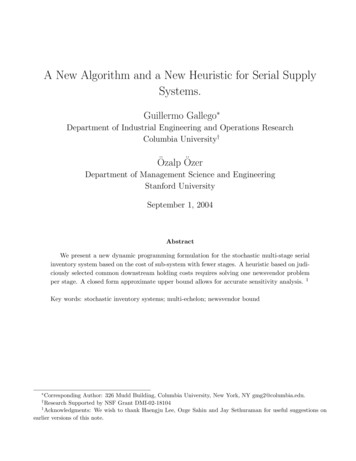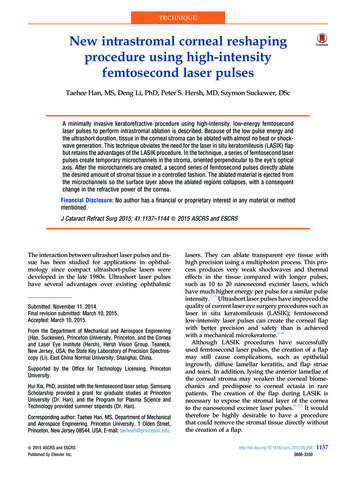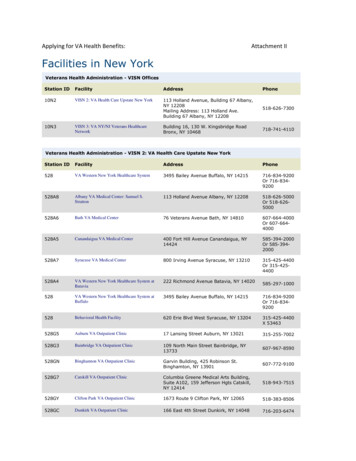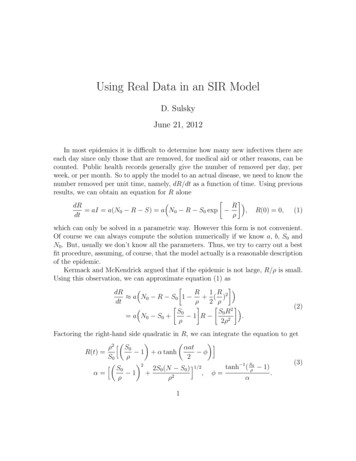
Transcription
IntroductionThis document is designed to help our clients understand the quality control requirements andlimitations of data reporting. There are three sections to this document. The first section will help todetermine data usability. The second section will discuss the regulatory and methodology limitations.The final section deals with hold time and preservation requirements. Click on the bookmarks to the leftfor more information.The following definitions may help you better understand the components of the data report.The Quality Control Section of ESS Laboratory's analytical report is located after the Sample Results.It is used to determine the data usability of the samples.The Method Blank is an analyte free matrix, (reagent water, clean sand, sodium sulfate), which iscarried through the complete preparation and analytical procedure. The Method Blank is used toevaluate contamination resulting from the complete preparation and analytical procedure.The Blank Spike (LCS) is an interference free matrix (same used for the Method Blank) spiked withknown concentrations of the analytes of interest. It is analyzed to determine, without sample matrix, ifthe procedure is working within established control limits. Like the Method Blank it is carried throughthe complete preparation and analytical procedure. It is routinely performed in duplicate as the BSD(LCSD). The recoveries of the spiked analytes are evaluated to determine accuracy. Comparison of theBS to the BSD will yield a precision measurement.The Matrix Spike is a separate aliquot of the sample spiked with known concentrations of the analytesof interest. It is analyzed to determine, including the matrix interferences, if the procedure is workingwithin established control limits. Like the Blank Spike it is carried through the complete preparation andanalytical procedure. It is routinely performed in duplicate as the MSD. The recoveries of the spikedanalytes are evaluated to determine accuracy in a given matrix. Comparison of the MS to the MSD willyield a precision measurement in a given matrix.The Duplicate is a separate aliquot of the sample carried through the complete preparation andanalytical procedure. Comparison of the Sample to the Duplicate will yield a precision measurement in agiven matrix.See Blank Spike/Matrix Spike for Blank Spike Duplicate and Matrix Spike Duplicate definitions.The Standard Reference Material is a third party standard with known concentrations in matrix similarto the sample.Surrogate Standards are analytes added to a sample at a known concentration in order to determineextraction efficiency. Surrogate Standards are analytes chemically similar to those being extracted.An Internal Standard is an analyte or group of analytes added to a sample at a constant concentration,for calibration and quantitation. The internal standard is an analyte chemically similar to those beingevaluated. It is typically added in GC/MS methods to correct analyte concentrations during analysis.The Continuing Calibration Verification is a check standard used to determine if the sample analysisis within control limits.
Quality Control SectionThe quality control section of the report is separated byanalysis and then batches within the analysis. A batch ofsamples consists of samples that were prepared at the same timeusing the same preparation method. A batch can consist of up to20 field samples prepared with a Method Blank (BLK), BlankSpike (BS or LCS), Blank Spike Duplicate (BSD or LCSDup), Matrix Spike (MS) and Duplicate (DUP)/Matrix SpikeDuplicate (MSD). These samples are designated as Batch#Abbreviation (ie BG92407-BLK1). The batch column on eachanalysis sheet will allow the data user to identify which QC isassociated with each analysis.
Method Blank (B)The Method Blank will show contamination that may haveoccurred during the preparation step. If the level of the analytein the blank is greater than 10% of the level of the analyte in thesample, the sample will be flagged. This will alert the data userthat a high bias should be taken into account. The flagged datawill only be reported when the analytes in question aresignificantly lower than the regulatory limits or insufficientvolume was received to perform a re-analysis. Levels ofanalyte in the blank below 10% of the level of the analyte in thesample would not be considered significant, should not beflagged and would not affect data usability.
Blank Spike (B ,B-)The Blank Spike is a measure of the accuracy of the testprocedure. If an analyte for any Blank spikes is outside ofcriteria, that particular analyte needs to be evaluated. If BlankSpikes are above criteria, there is possibility of a high bias;below criteria, there is a possibility of a low bias for theanalytes being evaluated. High bias would not be of concern forsamples under a regulatory limit. Low bias would be of concernfor samples that are under a regulatory limit depending onproximity to the limit. Extrapolation based on percent recoverywould be advisable, however extremely low recoveries wouldaffect data usability.
Matrix Spike (M ,M-)The Matrix Spike is a measure of accuracy with regards tomatrix effect. It is evaluated in the same way as the BlankSpike. The difference being that analytes that are outside ofcriteria in the Matrix Spike and not in the Blank Spike areshowing matrix effects. Again extrapolation can be usedhowever extremely low recoveries affect data usability.
Blank Spike Duplicate, Duplicate andMatrix Spike Duplicate (D )The Blank Spike Duplicate, Duplicate and Matrix SpikeDuplicate are measures of precision. The Blank SpikeDuplicate tests the precision of the procedure; the other two testthe precision in regards to matrix. If the Duplicate and/orMatrix Spike Duplicate are outside of criteria, while the BlankSpike Duplicate is acceptable, it is assumed that the sample isnon-homogeneous. This data would represent a range morethan a finite point.
Standard Reference Material (R ,R-)The Standard Reference Material is a measure of theaccuracy of the test procedure for a particular matrix. If ananalyte for any Standard Reference Material is outside ofcriteria, that particular analyte needs to be evaluated. If anyStandard Reference Material analytes are above criteria, there ispossibility of a high bias; below criteria, there is a possibility ofa low bias for the analytes being evaluated. High bias would notbe of concern for samples under a regulatory limit. Low biaswould be of concern for samples that are under a regulatorylimit depending on proximity to the limit. Extrapolation basedon percent recovery would be advisable, however extremelylow recoveries would affect data usability.
Surrogate Recoveries (S ,S-,SC,SM)Surrogate recoveries represent the extraction efficiency forgroups of analytes within a sample. Each surrogate represents agroup of analytes. If surrogate recoveries are above criteria, ahigh bias is assumed for that group of analytes; below criteria, alow bias is assumed. High bias would not be of concern foranalytes that are under a regulatory limit. Low bias would be ofconcern for analytes that are under a regulatory limit dependingon proximity to the limit. Extrapolation based on percentrecovery would be advisable, however extremely lowrecoveries would affect data usability. See Table forrelationship between analytes and the surrogates.When surrogates fail they may be qualified as confirmed(second run performed with same results) or matrix (matrixinterfered with quantitation of the surrogate – A chromatogramcan be provided to document the problem).SVOA Surrogate InformationVOA Surrogate InformationEPH Surrogate InformationUCM/Coelution (SM)It may not be possible to calculate Surrogate Recoveries due tounresolved complex mixture (UCM/Coelution). The surrogatepeak can not be distinguished or separated from the mixture ofcomponents that are present in the sample. A chromatogramcan be provided to document the problem.
Internal Standards (I,IC,IM)Internal Standards are used to quantify a group of analytes.If Internal Standard recoveries are outside of criteria, theanalytes represented by that particular Internal Standardneed to be evaluated. If the matrix has coeluted with theInternal Standard to create a higher result, the data wouldhave a low bias. Otherwise Internal Standards outside ofcriteria have caused the data to be adjusted more than themethod allows for but does not necessarily create a bias oneway or the other. This data is suspect and should not be usedfor important decision making. See Table for relationshipbetween analytes and the internal standards.When internal standards fail they may be qualified asconfirmed (second run performed with same results) or matrix(matrix interfered with quantitation of the internal standard – Achromatogram can be provided to document the problem).SVOA Internal InformationVOA Internal Information
Continuing Calibration Verifications, CCV(CD ,CD-)Continuing Calibration Verifications (CCVs) are used foranalyses that do not require a daily calibration. If CCVrecoveries are above criteria, a high bias is assumed for thatanalyte; below criteria, a low bias is assumed. High bias wouldnot be of concern for analytes that are not detected or under theregulatory limit needed. Low bias would be of concern foranalytes that are under a regulatory limit depending onproximity to the limit. Extrapolation based on percent recoverywould be advisable, however extremely low recoveries wouldaffect data usability.
Elevated Method Reporting Limits (EL)Elevated Method Reporting Limits are caused by targetanalyte dilution or matrix interferences.Samples are diluted when an analyte exceeds the highest levelcalibration standard. If the level of the analyte does not causethe run to be unusable, the original run and diluted run can bereported. If the level of the analyte causes the run to be unusable(saturates the detector), only the diluted run will be reported andflagged for Elevated Method Reporting Limits.Samples are also diluted when there is a large matrixinterference that cannot be cleaned up prior to running thesample. The sample must be diluted so that the interference doesnot mask the analyte(s). Once the interference has been negated,the analyte(s) can be reported. This may cause the MethodReporting Limit to exceed the method limits or the regulatorylimit. In this case, the sample will be flagged accordingly.Diluted Below (SD)It is not always possible to evaluate surrogate and matrix spikerecoveries in a diluted sample. If the dilution is large enough,the concentrations of surrogates will be diluted below theMethod Reporting Limits. These samples will be flaggedaccordingly.
Matrix Masked/Coelution (DM,MD,MM,MT)Samples with high target values or matrix interferences canmask the recovery of the analytes or co-elute with the analytes.The analytes can not be accurately distinguished or separatedfrom the existing concentrations of target analytes or otherunknown components that are present in the sample. Thesesamples will be flagged accordingly.
Quadratic Regressions (Q)Quadratic Regressions are an allowable form of calibrationfor organic compounds. This calibration should be kept to aminimum. A large number of quadratic regressions indicate thatthe instrument is not running properly. Analytes using quadraticregression should not be evaluated outside of the calibrationrange (no “E” flags or “J” flags should be used).
Dual Column Confirmation (P)Some organic analysis using GC (Pesticides, PCBs, etc)requires dual column confirmation of all reportable results.Samples are run on two different columns and results shouldagree to within 40%. Results outside of 40% are reviewed byanalysts for interference or coelution and flagged accordingly.The result reported is the value considered to have the bestchromatography.
Benzidine/Pentachlorophenol Tailing Factor (BT,PT)Tailing factor is used to evaluate the performance of theSVOA Mass Spec instrument. When the tailing factor is 2, thecolumns are showing some signs of deterioration which willoccur with continual use. The tailing factor must be narratedand instrument maintenance will be performed as necessary.This may affect the chromatography of all analytes, however, itdoes not add bias to the data reported.
Initial Calibration Verification (ICV)The Initial Calibration Verification is a second sourcestandard used to verify the calibration curve. While the CAMallows for some failures, it is not possible to judge the bias ashigh or low.
Estimated Value (E)When an analyte is reported above the high point of thecalibration curve, the analyte is considered an Estimated valueand qualified accordingly.
Potential Presence of PCBs (PP)The PP Qualifier is used when the chromatogram shows thepotential presence of PCBs in a sample. While the peaks andpatterns may not be exact, the analyst has determined that thePCB may be present in a weathered state.
Reducing Conditions (R)The eH-pH data is used to determine whether Chromium couldexist in the Hexavalent state in a particular sample. The Rqualifier is used to explain the low matrix spike recoveries in asample when it is not possible for Hexavalent Chromium toexist.
Serial Dilution (SD )The Serial Dilution is used to determine matrix interference inMetals samples. For samples containing analytes greater then50 times the reporting limit, the serial dilution should be within10%. Results greater then 10% would indicate a low bias forthat analyte.
CAM Method Limitations1,4 – DioxaneMust use 8270D SIM8260 Aqueous1,2-Dibromoethane (EDB) – must use 8011 to achieve GW1 andRCGW1 limits.1,4-Dioxane – must use 8270 with isotope dilution to achieveGW1 and RCGW1 limits.8260 SoilMust use Low Level method to achieve S1GW1, S2GW2 andRCS1 limits aneMethylene Chlori
Dup), Matrix Spike (MS) and Duplicate (DUP)/Matrix Spike Duplicate (MSD). These samples are designated as Batch#-Abbreviation (ie BG92407-BLK1). The batch column on each analysis sheet will allow the data user to identify which QC is associated with each analysis. Method Blank (B) The Method Blank will show contamination that may have occurred during the preparation step. If the level of the .











